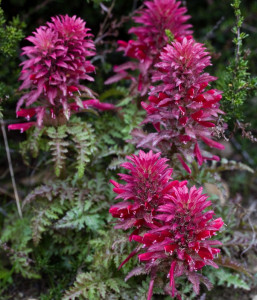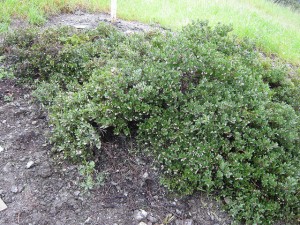On a tiny serpentine outcrop hemmed in by pavement, overshadowed by nonnative trees, and bathed in car exhaust, a lone plant of a species presumed extinct in the wild survived unknown for decades. That plant, a Franciscan manzanita, was discovered growing along busy Doyle Drive in San Francisco last October and is now the focus of a broad effort to reestablish its species in its native ecosystem.
Just over 100 years ago, botanist Alice Eastwood named this species Arctostaphylos franciscana from plants growing in the 54-acre Laurel Hill Cemetery, one of only three wild localities for the plant, all in San Francisco. By 1947, two sites had been lost to development, and bulldozers were demolishing Laurel Hill. James Roof, founding director of the Regional Parks Botanic Garden in Berkeley, salvaged some of the last remaining wild specimens. In a clandestine nighttime rescue, plantswoman Lester Rowntree “garnered it ghoulishly in a gunnysack” and gave it another home in her garden. A few more plants found their way into nurseries and botanic gardens, but the species’ only known wild habitat was gone.
Gone, that is, except an unlikely site on a tiny patch of serpentine habitat undamaged when the Golden Gate Bridge and its connector roads were built. Here, the lone Franciscan manzanita survived for decades, concealed even from botanists conducting surveys ahead of the Doyle Drive reconstruction. But when crews removed surrounding trees and shrubs, Daniel Gluesenkamp noticed the once-hidden plant as he drove by. Gluesenkamp, director of habitat protection and restoration for Stinson Beach-based Audubon Canyon Ranch, cofounded the Bay Area Early Detection Network, which coordinates response to newly introduced invasive weeds. “There’s a few of us watching the roadsides,” he says, “and when there’s a big change, it’s interesting.”
Gluesenkamp is an uncommonly good drive-by botanist, but the plant’s inaccessible location made precise identification nearly impossible. He surmised it could be the Presidio’s endangered Raven’s manzanita. His colleagues at the Presidio sprinted across fast-moving traffic to sample the plant, which turned out to be even rarer than imagined. “It felt like Christmas morning as a kid,” says Mark Frey, a Presidio Trust ecologist.
Without intervention, the plant would have been doomed–it was growing in the path of the new roadway construction. To give it legal protection, three organizations–Wild Equity Institute, the Center for Biological Diversity, and the California Native Plant Society–filed an emergency petition for Endangered Species Act protection. Concurrently, botanists confirmed the plant’s identity, and propagators collected cuttings and fruit as well as adjacent soil that might contain seed and essential microorganisms. With Caltrans’ support, cranes moved a 25,000-pound chunk of soil holding the manzanita to habitat similar to its wild site.
So far the transplant is thriving. But one plant cannot regenerate a genetically diverse population of its species, nor does a colony of one species make a functional ecosystem. Botanists analyzing relocated Laurel Hill manzanitas in botanic gardens hope to identify genetically distinct individuals that can be planted near the wild plant to interbreed and form a diverse population. Like many other restoration projects at the Presidio, this one will be a cooperative effort involving volunteers as well as scientists. “There’s a lot of activity now with a defined group of people working on the mother plant,” says Michael Chasse, stewardship coordinator with the National Park Service and lead author of the collaborative conservation plan for the manzanita. “That plant will go to a natural area . . . and the long-term care of sites and habitat in the Presidio is done by volunteers.”
Volunteers at the Golden Gate National Parks Conservancy’s nurseries are already working with experts like nurseries director Betty Young to propagate the Franciscan manzanita along with other maritime chaparral plants. Next, Presidio Park Steward volunteers, who work to enhance native habitat, will become the plant’s long-term caretakers. “There aren’t many times in your career that you get to save a plant that was thought to be extinct in the wild,” says Young.

.jpg)



